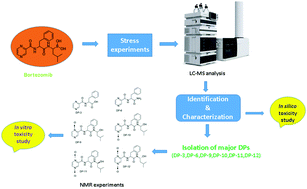Stress degradation study of bortezomib: effect of co-solvent, isolation and characterization of degradation products by UHPLC-Q-TOF-MS/MS and NMR and evaluation of the toxicity of the degradation products†
Abstract
Bortezomib (BTZ) is a first-in-class, potent reversible inhibitor of proteasome used in the treatment of multiple myeloma, the second most common hematological cancer. Stress degradation studies were performed to investigate the inherent stability of the drug according to ICH recommended guidelines Q1A (R2). Stress experiments were carried out in two ways using acetonitrile and methanol as co-solvents under various conditions. A selective stability-indicating LC-MS method has been developed to separate all degradation products of the drug on a Hibar-Purospher STAR, C18 (250 × 4.6 mm, 5 μm) column using a mobile phase consisting of 0.1% formic acid and acetonitrile in the gradient mode. BTZ was found to undergo degradation under acidic, basic, neutral hydrolysis and oxidative conditions, whereas it was stable under other conditions. Thirteen degradation products (DP-1–DP-13) were identified using acetonitrile as a co-solvent. Additionally, three (DP-14–DP-16) degradation products were found where methanol was used as a co-solvent. A total of 16 (DP-1–DP-16) degradation products were characterized by liquid chromatography-tandem mass spectrometry (LC-ESI-Q-TOF/MS/MS) and high-resolution mass spectrometry (HRMS). Major degradation products, DP-3, DP-6, DP-9, DP-10, DP-11 and DP-12, formed under oxidation conditions were isolated using preparative HPLC and characterized by 1D and 2D NMR experiments. Furthermore, in vitro cytotoxicity of isolated DPs was tested on normal cell lines such as CHO-K1, HEK-293 and NRK-49F by MTT assays. This study revealed that they were around 2–6 times less toxic as compared with the standard control of the drug and DP-10 showed relatively more toxicity than other isolated DPs against rat kidney cells at 18.20 μM. In silico toxicity studies suggested that BTZ and its DPs can be hepatotoxic and genotoxic resulting in severe toxicity.



 Please wait while we load your content...
Please wait while we load your content...